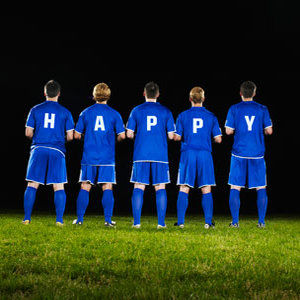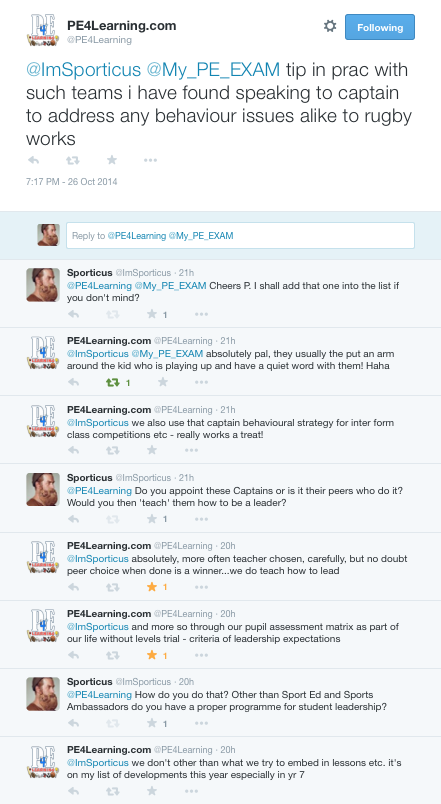Well of course a seating plan for core PE isn’t possible as it is a practical subject, but the idea below is something I have used for the last three years that is as near as possible as I can come to one.
At the beginning of the year I split my Year 7, 8 and 9 PE classes up into four teams. The teams are based on either my baseline assessment data that I get from them at the beginning of Year 7, or their end of Year 7 and 8 grades. I try to make the teams as equal on ability as possible.
All my Year 7 to 9 classes have 32 students so obviously I have teams of 8. In each team I aim to have two high performing students and two low performing students with the rest a mixture of ability. I generally try to have at least one person in each group that another will be able to work with. I organise this in advance of the first lesson so I am happy with the groupings. They are to stay in these groups for the whole year (but I am flexible if there are issues, however I prefer to work through these and try to find solutions first). The school I work at uses SIMS and that allows you to download class photos. I arrange the photos so they are in the teams. I take a photo of this on the iPad and link it to my register in iDoceo as well as having paper copies. This allows me to identify students a little easier, especially in Year 7.
In the very first lesson of the year I organise the teams. Each team is given a name, which is usually based on American Sports teams. This year I have gone for Cowboys, Vikings, Patriots and Chargers. Each team is given a home and away colour, with each team responsible for collecting their coloured bibs before the lesson. They are also expected, where we play competitive sports, to collect a referee bib and whistle. I explain the possible roles that I may ask them to have; captain, coach, referee, warm-up leader, kit manager etc.
This simple approach has really helped speed up the organisation of my lessons, especially at the beginning and also I feel it has reduced behavioural issues. I shall give you some practical examples of how this has helped:
- I can ask specific teams to be in charge of collecting and returning equipment. This works in all activities, even gymnastics where I can ask the Patriots to set up the mats and the Vikings the benches etc with the Cowboys and Charges to put them away. If teams don’t do it well or to my standard they may get asked to do more.
- We have a whiteboard outside our PE office, I can write instructions up on the board to help prepare students before a lesson.
- As teams are already in 8, I can organise them more quickly, such as a 4 v 4 small sided game or a 6 v 2 attacking drill or a pair practice.
- Each team having a home and away colour allows them to organise attackers/defenders or teams within their own teams more quickly.
- If a student is ill or injured I can still get them to work with their team as a coach or analyst – I found this has helped learning and engagement of students when unable to take a physical part in PE. We expect all students who can’t take a physical role within PE, but still in school, to get dressed in a tracksuit and take an active role with their team.
- If a student is away I find it easier to organise potential issues when in a smaller team.
- Having a referee bib and whistle for each team allows me to get one of them to referee games which is great in waterpolo, wrestling etc.
- Having them in the same small teams allows me to learn names more quickly, which is great for Year 7.
- I have teams already made if i ever want to play a tournament or larger 8 v 8 games.
- I can give individuals in the team responsibilities such as warming up or coaching. This allows me to set up for the lesson whilst they are occupied. Linking how seriously they take those responsibilities, can be linked to goals/points advantage when they play games or whether they need to collect in equipment at the end of the lesson, can help improve the standards.
- It allows me to talk to individual teams about common errors in their group, whilst the other teams keep working.
- If one team picks up something very quickly I can move them on, and then use them as a demo to the other teams
- I can use the high ability students in the team to mentor the lower ability students.
- Another member of staff said I can link team performance in activities to our whole school reward policy (I’m still thinking this one through).
Paul from pe4learning gave a really good example of how to develop student leadership through this idea.
Making teams in Core PE and keeping them throughout the year has really helped increase my teaching time by reducing organisation time. The students like it because they get the sense of belonging to a team and enjoy the competitive element over the course of the year. In activities such as dance, gymnastics and athletics it helps with the organisation of equipment and running of the lessons. There is less time standing still and therefore the potential to misbehave is reduced from my experience. Some students though have raised concerns that they might not necessarily get to work with everyone in the class.
If you are a little disappointed that this post wasn’t about actual seating plans then you can find some far wiser people than me blogging about it below:
Quick tips for NQT’s – Old Andrew
Having engaged with other teacher online they have recommended some technology that can help:
@TedfordDanielle recommended Class Charts which her school has bought into and integrated with SIMS
Mint Seating Plan is something I’ve seen a lot of teachers recommend
and this is what I use iDoceo
Let me know if you try it out and how it goes for you. If you have any advice on how I can improve or tweak this idea then please let me know.



Reblogged this on The Echo Chamber.
LikeLiked by 1 person
Another good one, pal. Keep them coming. J
LikeLike